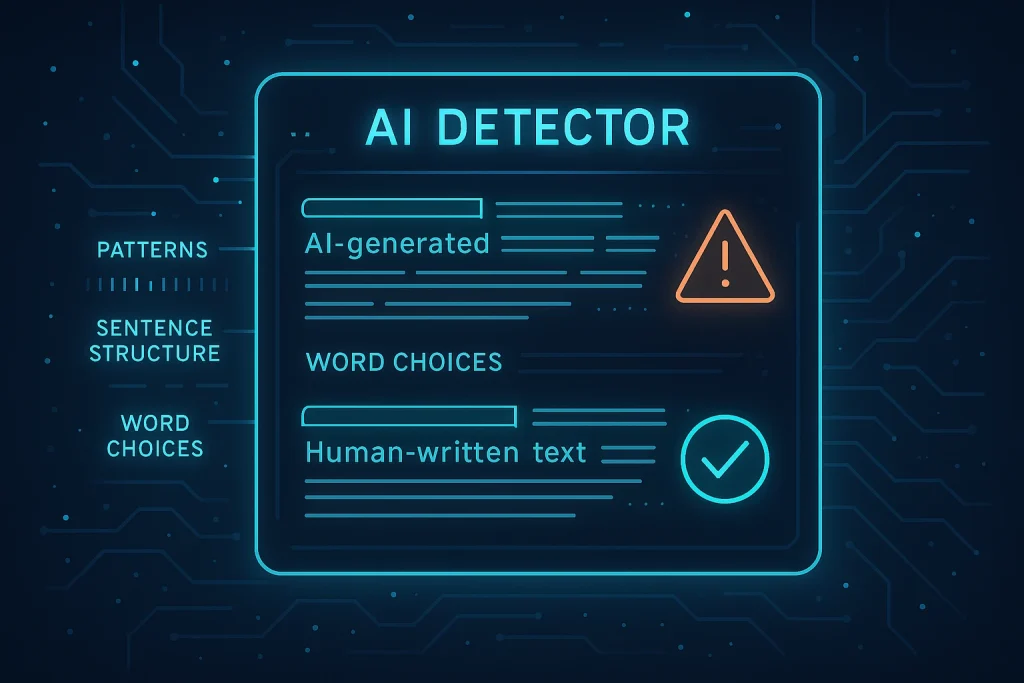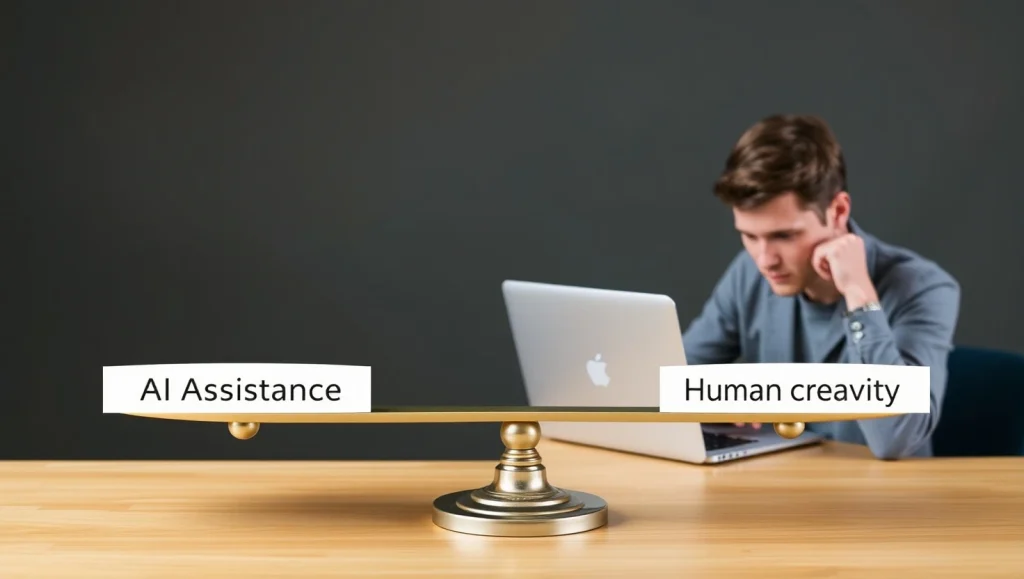Introduction
AI-generated content is everywhere. Blogs, academic papers, and social media posts use it. But many platforms now check for AI-written text. They use AI detectors to find and flag it. Whether you’re a writer, student, or marketer, making AI content sound human is important. Knowing how to not get detected by AI detector helps you keep your writing authentic.
AI detectors check patterns, sentence structure, and predictability. They look for repeated phrases, robotic tone, and unnatural fluency. If flagged, your content could be rejected or lose credibility. To avoid this, you must make AI text more natural.
How can you do that? The key is to make it sound human. Add personal touches and vary your writing style. Use different sentence structures and avoid patterns. Simple changes, like rewording and manual edits, can help.
This guide will show you the best ways to make AI-assisted content undetectable. You’ll learn how to improve flow and tone. Whether you’re blogging, researching, or writing online, these tips will help. Let’s get started!
How AI Detectors Work

AI detectors find and flag computer-generated text. They use smart programs to tell the difference between AI-written and human-written content. Understanding how they work helps you write naturally and avoid detection.
1. Spotting Patterns and Predictable Text
AI writing follows patterns. Tools like ChatGPT pick the next word based on probability, making sentences structured and sometimes repetitive. AI detectors look at word choices, sentence length, and phrasing to see if writing seems robotic.
Humans mix up sentence styles, sometimes using unexpected words or small mistakes. AI keeps sentences neat and similar. If writing looks too smooth and repetitive, detectors may flag it.
2. Checking for Variation and Surprise
AI detectors measure two things: perplexity and burstiness.
- Perplexity checks how surprising words are. AI text is easy to predict, while human writing has more surprises.
- Burstiness looks at sentence variety. Humans use both short and long sentences, while AI sentences stay even. AI detectors flag content that looks too steady.
More variety makes text seem human.
3. Finding Repeated Words and Phrases
AI writing often repeats ideas or uses similar words too much. This happens because AI picks words by probability instead of real creativity. Detectors scan for repetition and unnatural synonyms.
If a phrase pops up often in slightly different ways, it might be AI-written. Detectors also check how often words appear compared to real human writing.
4. Looking for Emotion and Personal Touch
Human writing includes feelings, opinions, and unique thoughts. AI text often sounds neutral and lacks emotion. AI detectors look for strong opinions, personal stories, or conversational tones.
AI also avoids controversial or deep topics. If text feels too safe, AI detectors may flag it.
5. Grammar and Sentence Flow
AI writing is usually grammatically correct but sometimes feels awkward. AI detectors check if sentences sound natural.
AI often writes long, smooth sentences without pauses. Humans use contractions, idioms, and casual language. If writing is too formal or perfect, detectors suspect AI.
6. Matching AI Writing Styles
Some detectors compare text with known AI-generated content. If writing looks too much like GPT-4, Gemini, or Claude, it might be flagged.
AI detectors find machine-written text by spotting patterns, repetition, and lack of personal style. To avoid detection, mix sentence styles, add personal touches, and edit AI-written text. Making small changes can help your writing feel more human.
Techniques to Avoid AI Detection

AI detectors are getting better at spotting machine-written content. If you want to pass AI detection, your writing needs to sound natural. Here’s how to not get detected by AI detector while keeping your content clear and engaging.
A. Write Like a Human
The best way to fool AI detectors is to write like a real person. AI follows patterns, so breaking them makes your writing feel more human.
- Vary sentence length – Use a mix of short and long sentences.
- Use contractions – Say “I’ve got a plan” instead of “I have a plan.”
- Add personality – Share thoughts, feelings, and experiences.
Example:
“When I started writing online, I found it hard to structure my ideas. But I kept going and got better over time.”
B. Rewrite AI-Generated Text
If you use AI tools, don’t just copy and paste. Rewrite the content to sound more natural.
- Reword sentences manually – AI paraphrasers still follow patterns.
- Change sentence structure – Instead of “This method helps improve work speed,” say “Want to work faster? Try this.”
- Use both active and passive voice – AI sticks to one, so mix it up.
Example:
AI-generated: “Errors were made when setting up the account.”
Humanized: “People made mistakes when setting up the account.”
C. Use AI Text Enhancers
Some tools can help make AI-generated text sound more natural.
- Try QuillBot, Grammarly, or Hemingway Editor – They improve clarity and flow.
- Simplify sentences – AI often writes in a stiff, formal tone.
- AI Humanizer – Humanize AI Text Free Unlimited
Example before:
“The application of advanced techniques enhances workflow efficiency.”
After:
“Using better methods makes work easier.”
D. Blend AI and Human Writing
Mixing AI-generated content with personal touches makes it harder to detect.
- Add personal stories and examples – AI can’t do that.
- Write key sections yourself – AI intros and conclusions often sound robotic.
Example:
Instead of AI-generated: “AI is changing the way we work.”
Try: “I’ve seen how AI can speed up work, but human input still matters.”
E. Formatting Tricks to Evade Detection
How you format your text also plays a role in avoiding AI detection.
- Vary paragraph sizes – AI-generated content is often too uniform.
- Use rhetorical questions and humor – “Ever read something and thought, ‘This sounds fake’? That’s AI for you!”
- Add visuals – AI detectors focus on text, so include images or infographics.
If you want to know how to not get detected by AI detector, the secret is to sound human. Rewrite AI text, add personal touches, and change the structure. AI is a great tool, but a human touch makes your writing undetectable.
Common Mistakes to Avoid When Bypassing AI Detection
AI detectors are improving every day. If you want your content to sound human, you must avoid some common mistakes. Here are the biggest errors and how to fix them.
1. Relying Too Much on AI-Generated Content
A common mistake is copying AI text without making changes. AI writing follows patterns, making it easy to detect. If you don’t edit it, AI tools will flag it.
✅ How to fix it:
- Rewrite the text in your own words.
- Add personal stories or examples.
- Mix sentence lengths for a natural flow.
For example:
❌ AI-generated: “This method improves efficiency and productivity.”
✅ Humanized: “Want to get more done? Try this simple trick!”
If you’re wondering how to not get detected by AI detector, personalizing your writing makes a huge difference.
2. Depending Only on Paraphrasing Tools
Many people believe that paraphrasing tools help avoid detection. But these tools often keep the same structure, making the text still detectable.
✅ How to fix it:
- Rewrite content instead of just replacing words.
- Change sentence structure to sound natural.
- Read your text out loud to check flow.
Example:
❌ AI version: “Optimizing work strategies improves efficiency.”
❌ Paraphrased version: “Enhancing work methods increases productivity.”
✅ Humanized version: “If you want to work smarter, try adjusting your strategies.”
By rewriting manually, you improve readability and learn how to not get detected by AI detector while making your content sound real.
3. Skipping Proofreading and Editing
AI-generated text can be repetitive or robotic. If you don’t proofread, it will be easier to detect.
✅ How to fix it:
- Read your text carefully and make edits.
- Remove extra words or awkward phrases.
- Use tools like Grammarly to improve readability.
Example:
❌ Before: “It is important to carefully examine your work before publishing.”
✅ After: “Always check your work before publishing!”
Small changes like these make a big difference in making your content sound more natural.
Ethical Considerations & Best Practices: How to Not Get Detected by AI Detector

AI is now widely used in writing. It helps with speed and ideas, but there are ethical concerns. This article explains when AI use is okay, the risks in different fields, and how to mix AI with human creativity.
When AI-Generated Content Is Okay
AI writing can be helpful if used correctly. It is good for brainstorming, rough drafts, and improving text. Businesses use AI for reports and ads. Writers use AI for ideas and edits. But relying only on AI can cause problems, especially in schools and news. People must check facts and give credit when needed.
Ethical Issues in Schools, News, and SEO
In schools, using AI for full essays without credit is cheating. AI should be used for summaries or grammar help, not full papers. News must be accurate, so AI content needs fact-checking. For SEO, AI-written content made just to rank higher can get penalized. Writers should focus on quality content that blends AI with human effort.
Balancing AI and Human Creativity
AI makes writing faster, but human creativity is still key. Writers should use AI as a tool, not a replacement. Knowing how to not get detected by AI detector helps keep writing original. A mix of AI help and human editing ensures ethical and high-quality content.
conclusion
AI-generated content is helpful, but using it too much can cause problems. AI detectors look for patterns, so small changes make writing sound more human. Mixing sentence lengths, adding personal details, and rewriting AI text can help.
Good writing feels real. Whether for school, work, or online, balancing AI with human creativity keeps content original. Just knowing how to not get detected by AI detector is not enough. Focus on clear, engaging writing. AI should assist you, not replace your voice.Using AI responsibly means checking facts, limiting automation, and keeping a natural flow. Following best practices makes your content useful and undetectable. The key is balance: use AI for speed but keep your unique style. Done right, AI becomes a great tool for writing strong, original content while ensuring you know how to not get detected by AI detector effectively.







